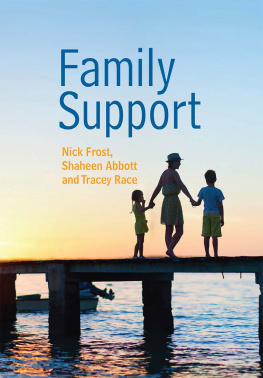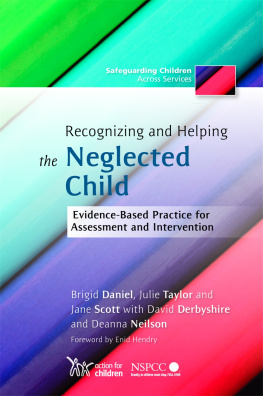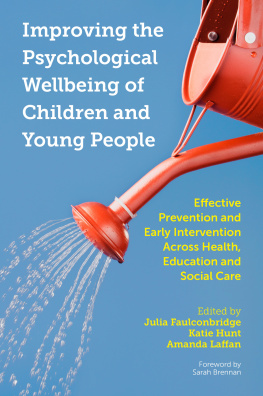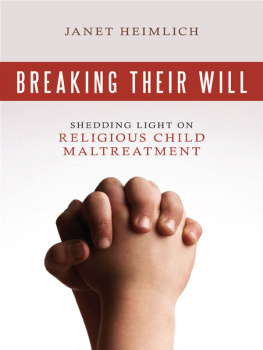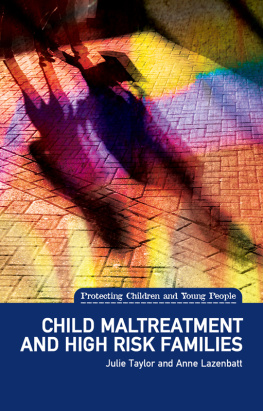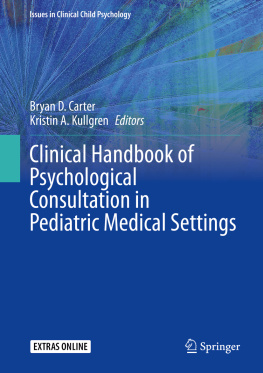Eradicating Child Maltreatment
by the same author
Safeguarding Children Living with Trauma and Family Violence
Evidence-Based Assessment, Analysis and Planning Interventions
Arnon Bentovim, Antony Cox, Liza Bingley Miller and Stephen Pizzey
ISBN 978 1 84310 938 9
eISBN 978 1 84642 938 5
of related interest
Child Protection and Child Welfare
A Global Appraisal of Cultures, Policy and Practice
Edited by Penelope Welbourne and John Dixon
ISBN 978 1 84905 191 0
eISBN 978 0 85700 421 5
Direct Work with Vulnerable Children
Playful Activities and Strategies for Communication
Audrey Tait and Helen Wosu
ISBN 978 1 84905 319 8
eISBN 978 0 85700 661 5
Effective Working with Neglected Children and their Families
Linking Interventions to Long-term Outcomes
Elaine Farmer and Eleanor Lutman
ISBN 978 1 84905 288 7
eISBN 978 0 85700 609 7
Child Protection Systems in the United Kingdom
A Comparative Analysis
Anne Stafford, Nigel Parton, Sharon Vincent and Connie Smith
ISBN 978 1 84905 067 8
eISBN 978 0 85700 254 9
Child Development for Child Care and Protection Workers
Second edition
Brigid Daniel, Sally Wassell and Robbie Gilligan
ISBN 978 1 84905 068 5
eISBN 978 0 85700 112 2
Safeguarding Children From Emotional Maltreatment
What Works
Jane Barlow and Anita Schrader McMillan
ISBN 978 1 84905 053 1
eISBN 978 0 85700 364 5
ERADICATING CHILD
MALTREATMENT
Evidence-Based Approaches to Prevention
and Intervention Across Services
Edited by Arnon Bentovim and Jenny Gray
Foreword by Harriet Ward
Jessica Kingsley Publishers
London and Philadelphia
First published in 2015
by Jessica Kingsley Publishers
73 Collier Street
London N1 9BE, UK
and
400 Market Street, Suite 400
Philadelphia, PA 19106, USA
www.jkp.com
Copyright Arnon Bentovim and Jenny Gray 2015
Foreword copyright Harriet Ward 2015
All rights reserved. No part of this publication may be reproduced in any material form (including photocopying or storing it in any medium by electronic means and whether or not transiently or incidentally to some other use of this publication) without the written permission of the copyright owner except in accordance with the provisions of the Copyright, Designs and Patents Act 1988 or under the terms of a licence issued by the Copyright Licensing Agency Ltd, Saffron House, 610 Kirby Street, London EC1N 8TS. Applications for the copyright owners written permission to reproduce any part of this publication should be addressed to the publisher.
Warning: The doing of an unauthorised act in relation to a copyright work may result in both a civil claim for damages and criminal prosecution.
Library of Congress Cataloging in Publication Data
Eradicating child maltreatment : evidence-based approaches to prevention and intervention across services / edited by Arnon Bentovim and Jenny Gray.
pages cm
Includes bibliographical references and index.
ISBN 978-1-84905-449-2 (alk. paper)
1. Child welfare. 2. Child abuse. 3. Child abuse--Prevention. I. Bentovim, Arnon. II. Gray, Jenny.
HV713.E73 2015
362.767--dc23
2014021851
British Library Cataloguing in Publication Data
A CIP catalogue record for this book is available from the British Library
ISBN 978 1 84905 449 2
eISBN 978 0 85700 823 7
Contents
Harriet Ward
Jenny Gray, OBE, International Society for the Prevention of Child Abuse and Neglect (ISPCAN) and Social Work Consultant, UK
Arnon Bentovim, Visiting Professor, Royal Holloway, University of London, UK
Jenny Woodman, UCL Institute of Child Health, UK and Ruth Gilbert, UCL Institute of Child Health, UK
Jane Barlow, Warwick University, UK
Ron Prinz, Professor and Director of Parenting and Family Research Center, University of South Carolina, USA
Bruce F. Chorpita, University of California, Los Angeles and Practice Wise LLC, USA, Alayna Park, University of California, Los Angeles, USA and Eric L. Daleiden, Practice Wise LLC, USA
Arnon Bentovim
Arnon Bentovim
Donald Findlater, The Lucy Faithfull Foundation, Birmingham, UK
Arnon Bentovim and Jenny Gray
FOREWORD
Harriet Ward
Historically, there have been times when it was possible to assume that child abuse and neglect did not occur. In nineteenth-century America, the assertion that children might need to be protected from abuse or neglect by parents and others who had responsibility for them was regarded as so outrageous that the case that led to the New York Society for the Prevention of Cruelty to Children in 1874 was prosecuted under animal welfare legislation. In the UK, for nearly a century, the issue shifted in and out of the public consciousness, at one point being a major source of concern, and then forgotten or ignored for lengthy periods. The London Society for the Prevention of Cruelty to Children was founded in 1884, at a time when concerns were beginning to be raised about the prevalence of physical and sexual abuse and neglect; its activities sparked off debates concerning the limitations of the fathers right to chastise his children as he saw fit. The rights debate was almost always framed from the fathers perspective, rarely ever the mothers, and certainly not the childs. However, throughout the first half of the twentieth century, apart from concerns raised following the death of Denis ONeil at the hands of his foster carers in 1945, the issue was largely forgotten or hidden, and professionals could have been forgiven for assuming that child abuse and neglect simply did not happen in supposedly civilised countries.
Kempe and colleagues seminal paper on The battered-child syndrome, published by the Journal of the American Medical Association in 1962, marked the point at which the prevalence of child abuse and neglect could no longer be ignored (Kempe 1926). Since then, the work of the International Society for the Prevention of Child Abuse and Negelct (ISPCAN), the UN Committee on the Rights of the Child, and numerous other national and international bodies have made it clear that the maltreatment of children is a very real issue in every country. A wealth of empirical research has also shown that the long-term impact of childhood abuse and neglect on health and well-being, and the costs to society of widespread prevalence, are such serious issues that they cannot be left to local or national initiatives to resolve. The maltreatment of children needs to be faced and addressed on an international basis.
In 1978 Henry Kempe, the founder of ISPCAN, argued that societies and professionals with safeguarding responsibilities needed to go through a number of stages until they reached a position in which it was possible to guarantee that every child is wanted, loved and cared for, sheltered, fed and receives first class preventative services and health care (Kempe 1978). We are still very far from that position today.
Nevertheless there have been a number of advances towards this goal. The promotion of childrens rights encapsulated in the United Nations Convention on the Rights of the Child (UNCRC), international initiatives to prevent female genital mutilation, trafficking and sexual exploitation of children and the introduction of legislation banning physical abuse in a number of countries have undoubtedly been steps in the right direction.


